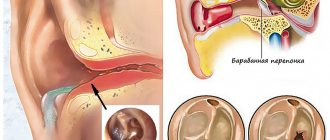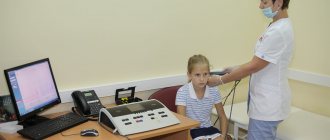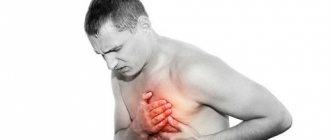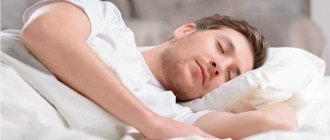Ear pain - mild or intense, shooting or aching - is a symptom that can indicate both a disease of the hearing organ and pathological processes occurring in nearby organs and tissues. According to statistics, otitis media is the most common cause of ear pain. However, the diversity of its forms and many other diseases with similar symptoms require accurate diagnosis and different treatment approaches. To establish the true causes of ear pain, it is necessary to be examined by an otolaryngologist, and sometimes by a neurologist, dentist, and even a cardiologist.
At CELT you can consult an otorhinolaryngologist.
- Initial consultation – 3,000
- Repeated consultation – 2,000
Make an appointment
Otitis externa
Most often, inflammation of the outer ear is bacterial in nature.
The causes of infection may be:
- trauma to the external auditory canal, for example, from a sharp or blunt object, or from a hearing aid;
- skin defects due to eczema, psoriasis, diabetes and other diseases;
- too thorough removal of earwax, which creates an acidic environment that prevents the growth of microbes;
- frequent entry of water into the outer ear (“swimmer’s disease”).
Symptoms of external otitis:
- acute ear pain, aggravated by pressing on the tragus or pulling the earlobe;
- possible itching and a feeling of “stuffiness” in the ear;
- discharge of a purulent or bloody nature, sometimes having an unpleasant odor;
- examination reveals swelling and hyperemia of the external auditory canal;
- possible hearing loss;
- enlargement and tenderness of the lymph nodes in the neck and behind the ear on the affected side.
The course of the disease may be complicated by a perforation of the eardrum, which cannot be determined without a visit to an ENT specialist.
External otitis of fungal origin is a common phenomenon, usually occurring in patients with low immune status or due to long-term use of antibacterial drops. It is characterized by severe itching, the formation of crusts, profuse thick discharge and the absence of a therapeutic effect from the use of antibiotics.
Separately, it is worth noting the localization of a boil on the skin of the external auditory canal or inflammation of the atheroma. The clinical picture is similar to otitis externa, but upon examination there is a more localized focus of inflammation with an opening from which pus and blood can be discharged.
Ear compresses for the right and left ears
In addition to drug treatment, patients are advised to use warm ear compresses based on alcohol or camphor oil. To prepare them you will need:
- Compress with camphor oil - cut a hole in the center of the gauze napkin into which the ear could fit. Next, soak a napkin with camphor oil, wring it out and apply it to the sore ear, threading it through the hole. Finally, apply cotton wool and secure the compress with a bandage. The compress is replaced every hour (but can be left overnight).
- Alcohol compress - 20-25% alcohol is diluted with water (1:1) and a gauze cloth is moistened in it, then the compress is applied to the ear in the same way as described above and kept for 30-40 minutes.
a cut is made in the gauze for the ear.
Before applying an alcohol compress, the skin around the ear is first lubricated with a thick cream (so as not to cause a burn). If the patient's body temperature is higher than normal, then any warming compresses are contraindicated .
Otitis media
The middle ear communicates with the nasopharynx through the Eustachian tube, through which infection can penetrate from the upper respiratory tract due to acute respiratory viral infections, influenza, sore throat, rhinitis, sinusitis and other diseases. Children are especially often affected because their Eustachian tube is short and wide, which makes it easier for infection to enter. The process can be one- or two-way.
Symptoms of acute otitis media:
- pain in the ear from moderate to severe, pulsating in nature (pain does not depend on pulling the lobe or pressing on the ear canal);
- increased body temperature;
- possible noise in the ear, dizziness, decreased hearing acuity;
- the presence of discharge (mucous, purulent, bloody) indicates a perforation of the eardrum.
With an aggressive course of the inflammatory process and the absence of adequate therapy, otitis media is fraught with such serious complications as meningitis, sepsis, intracranial abscess formation, and deafness.
What to do if your ears hurt when you have a cold?
Aching pain in the ears can occur due to a cold. Due to the close proximity of the ENT organs, the infection spreads to neighboring areas: for example, a sore throat is often accompanied by a runny nose, and rhinitis leads to painful pressure in one or both ears. Why is this happening?
When you have a runny nose, your paranasal sinuses become inflamed and swollen. This interferes with the normal removal of fluid, mucus accumulates, and bacteria begin to actively multiply in it. Gradually, irritation affects the Eustachian tube, sensations of unpleasant itching and pressure on the ears appear, and pain occurs. To avoid this, during a cold it is necessary to use vasoconstrictor nasal drops: they restore normal ventilation in the sinuses and reduce the risk of inflammation of the Eustachian tube.
If you consult a doctor in time and follow the prescribed treatment, ear pain due to a cold will quickly go away. But if you have already recovered, and the discomfort in your hearing organs has not gone away, there is a risk of developing complications. In this case, you need to make an appointment with an ENT specialist as soon as possible.
Inflammation of the inner ear (labyrinthitis)
The labyrinth is an organ of hearing and balance, is richly innervated and includes auditory and kinetic receptors, so its inflammation causes:
- severe ear pain and headaches;
- a sharp decrease in hearing, the appearance of noise, crackling, squeaking in the ear;
- dizziness, nausea, loss of orientation in space, horizontal nystagmus.
Labyrinthitis occurs as a result of the penetration of infection in various ways from different parts and cavities of the body:
- from the middle ear with untreated or advanced otitis media;
- with infected meninges during meningitis;
- with blood for diseases such as syphilis, tuberculosis, herpes;
- damage to the temporal region, the organ of hearing with disruption of the integrity of cells and blood vessels.
The disease requires immediate medical attention.
Eustachite
Eustachitis is an inflammation of the canal connecting the middle ear to the nasopharynx. The degree of pain varies. Characteristic features are:
- feeling of stuffiness in the ear;
- noise and crackling in the ear, the patient hears his voice as too loud with a weakened perception of extraneous sounds;
- sensation of water pouring into the ear.
In the absence of timely treatment, eustachitis becomes chronic, causing chronic exudative otitis media.
Ear pain of non-infectious origin
Ear tumors
Neoplasms are most often localized in the outer and middle sections; tumors of the labyrinth are an extremely rare phenomenon. Malignant formations of the outer ear are accompanied by severe pain: the pain is burning and radiates to the temple. Possible bleeding; When the ear canal is obstructed, conductive hearing loss develops. If the middle section is affected, the symptoms are similar to otitis media; a high degree of hearing loss and intense pain, increasing in the evening, should alert you. When the process spreads, symptoms of damage to neighboring structures arise: loss of orientation in space, paresis of the facial nerve, trigeminal neuralgia.
Ear injuries
- Mechanical injuries. The auricle most often suffers with the formation of lacerations and damage to cartilage. Blunt trauma to the ear usually results in a hematoma. As a result of trauma to the ear canal, the ear hurts greatly, there is a feeling of stuffiness, and bleeding is possible. Such symptoms are an indication to consult a doctor, since rupture of the eardrum and fractures of the skull bones are possible.
- Barotrauma is caused by a difference in pressure in the external environment and the cavity of the middle ear, for example, during a sharp loud sound (explosion), take-off/landing of an airplane, deep-sea immersion (diving), climbing a mountain. As a result, the eardrum is pulled inward, which is accompanied by pain, noise or ringing, and congestion in the ears. The opposite situation is also possible, when a decrease in atmospheric pressure causes the membrane to bulge outward. As a rule, unpleasant sensations go away on their own, however, if sharp pain is noted, it makes sense to check the integrity of the tympanic membrane when examined by a doctor.
- Entry of a foreign body in the form of small objects or insects causes swelling of the skin of the ear canal, itching, pain, and sometimes hearing loss. Attempting to remove a foreign object yourself can damage the eardrum.
- With burns and frostbite of the ears, **pain // of varying intensity is observed, depending on the degree of damage.
- Conventionally, ear injuries include the formation of wax plugs, which irritate the skin of the ear canal, causing discomfort and tinnitus. Removal should be carried out by an otolaryngologist.
First aid
If an adult’s ear hurts, then at home you need to relieve the acute pain yourself. Regardless of the intensity of the pain, the patient must insert a cotton pad soaked in boric alcohol. The following tactics are:
- Take painkillers if the pain is unbearable. Paracetamol or ibuprofen will do.
- Topical corticosteroids are used in the nose to relieve swelling of the mucous membranes and normalize ventilation of the ear canals. The condition improves after 10-20 minutes.
- If the pain does not go away, you can put ear drops in each ear, regardless of which ear hurts. The product is first warmed up in the palms.
It is necessary to avoid drafts, not to go outside unless absolutely necessary, and to avoid contact with water when washing your hair. Important to remember! You cannot make compresses, instill ear drops with an antibacterial effect, or warm up the area of inflammation if there is any discharge from the ear.
Ear pain due to diseases of other organs
- Mastoiditis - inflammation of the mastoid process - causes intense throbbing pain in the ear, swelling of the tissue behind the auricle, hearing loss, and hyperthermia.
- With arthrosis and arthritis of the temporomandibular joint, the patient is bothered by shooting pains in the ear, which intensify when chewing, a crunching sound in the temple area, and over time, hearing impairment and malocclusion are possible.
- Mumps is an inflammation of the salivary gland located in front of the auricle, accompanied by acute pain in the ear, aggravated by swallowing and chewing, and swelling of the tissues.
- Inflammation of the parotid lymph nodes (lymphadenitis) develops when infection penetrates into them from diseased teeth or from other foci of inflammation.
- Inflammatory diseases of the nasopharynx and sinuses, malignant processes in the larynx and oral cavity are often accompanied by pain in the ear when swallowing.
- Caries, pulpitis. Since the organ of hearing, like the teeth, is innervated by the branches of the trigeminal nerve, damage to the teeth and jaw may be accompanied by pain in the ear area.
- An atypical form of heart attack, when the patient’s only subjective complaint is pain in the ear.
Diagnostics
The diagnosis and treatment of pathologies associated with this symptom is carried out by an ENT doctor (otorhinolaryngologist) or an audiologist (a narrower specialty in otorhinolaryngology). During the appointment, the specialist talks with the patient, examines him, conducts the necessary examination, and establishes a diagnosis.
The multidisciplinary CELT clinic employs experienced, highly qualified otolaryngologists. Rich clinical experience helps them make the correct diagnosis in the most difficult cases.
Prevention
Preventive procedures involve eliminating factors that cause pathology:
- Identify and eliminate pathologies of the ENT organs in a timely manner, without leading to relapses.
- Do not use ototoxic drugs.
- Patients who constantly interact with complex production factors should undergo audiometry 2 times a year.
- We need a healthy lifestyle.
- Multivitamins should be taken in spring and autumn.
- Ears need to be covered with something in production where it is noisy.
- Use a hat in winter.
Treatment
Treatment of inflammatory ear diseases includes:
- antibacterial, antiviral agents of local and general action;
- antipyretics, analgesics;
- physiotherapy;
- in some cases - surgical intervention.
Treatment must be based on accurate diagnosis, which is impossible outside a specialized clinic. The high professionalism of CELT specialists allows us to identify various diseases of the hearing organ and choose the most effective means of solving the problem.
Make an appointment through the application or by calling +7 +7 We work every day:
- Monday—Friday: 8.00—20.00
- Saturday: 8.00–18.00
- Sunday is a day off
The nearest metro and MCC stations to the clinic:
- Highway of Enthusiasts or Perovo
- Partisan
- Enthusiast Highway
Driving directions











